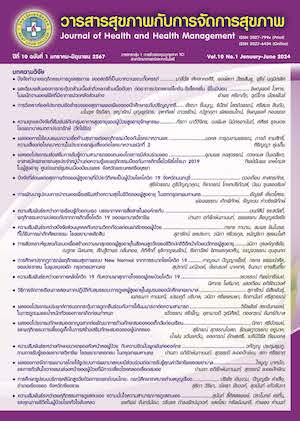The Effects of Using the Health Belief Model on Diabetes Preventive Behaviors and Risk of Diabetes in the Population at Risk for Type 2 Diabetes
Keywords:
diabetes preventive behaviors, risk of diabetes, health belief model, population at risk for type 2 diabetesAbstract
This one-group quasi-experimental research using pre-test, post-test, and follow-up design, aimed to study the effect of using a health belief model on diabetes preventive behaviors and diabetes risk in populations at risk for type 2 diabetes. The sample group was 28 academic support personnel in an educational institution in Bangkok who were at risk for type 2 diabetes. The research was conducted over a period of 16 weeks, 12 weeks were allotted for the intervention and another 4 weeks were provided for the follow-up period. The sample group was given the programs which consisted of educational sessions on the 1st-2nd week and followed-up by providing individualized feedback on health status information, prompting and providing 3 consultations on the 4th, 8th, and 12th, and exchanging information through the LINE application throughout the experimental period. On the ward, the data were collected in the post-test phase on the 12th week and the follow-up phase on the 16th week. The diabetes preventive behavior questionnaire was developed by the researcher (CVI = 1.00, Reliability = .75) and collected data on risk factors for diabetes, including body mass index, waist circumference, and blood pressure. Measuring was in the pre-test, post-test, and follow-up period. The statistical analysis was performed by using percentages, means, standard deviations, and repeated measure ANOVA. The results found that the sample group had a mean score on health behaviors to prevent type 2 diabetes increased more than and there is a risk factor for developing type 2 diabetes, namely body mass index and the waist circumference decreased less than before receiving the health belief program with statistical significance at the .05 level. This finding suggests that the health belief program should be used to promote the population at risk for type 2 diabetes by emphasizing on reducing the obstacles of the sample group to the point and continuously throughout the project to develop healthy behaviors to prevent type 2 diabetes. Continuously, this will help reduce the risk of developing type 2 diabetes. Keywords: diabetes preventive behaviors, risk of diabetes, the health belief model, population at risk for type 2 diabetes.
References
กองโรคไม่ติดต่อ กรมควบคุมโรค. (2565). รายละเอียดตัวชี้วัดเพื่อกำกับติดตามคุณภาพบริการ การดำเนินงานด้านโรคไม่ติดต่อ (โรคเบาหวานและโรคความดันโลหิตสูง) ประจำปีงบประมาณ พ.ศ. 2565. สืบค้นจาก https://ddc.moph.go.th/uploads/publish/1186620211005081047.pdf
เกษร ศรีธรรมมา. (2563). ผลการใช้กิจกรรมกลุ่มและแบบแผนความเชื่อด้านสุขภาพที่มีผลต่อพฤติกรรมการดูแลตนเองของกลุ่มเสี่ยงโรคเบาหวานในจังหวัดร้อยเอ็ด. วารสารวิจัยและพัฒนานวัตกรรมทางสุขภาพ, 1(3), 177-189.
คณะแพทยศาสตร์ มหาวิทยาลัยมหิดล. (2557). ผลของโปรแกรมการใช้แบบแผนความเชื่อด้านสุขภาพร่วมกับการส่งเสริมความสามารถของตนโดยพยาบาลสามารถลดระดับฮีโมโกลบินเอวันซีในประชาชนที่มีความเสี่ยงต่อการเกิดโรคเบาหวานชนิดที่ 2 ที่มารับบริการ ณ โรงพยาบาลศิริราช:การศึกษาแบบสุ่มระยะที่สาม. สืบค้นจากhttps://op.mahidol.ac.th/qd/km/document/2014/km20141218/066.pdf
ธเรศ กรัษนัยรวิวงค์. (2565). สถานการณ์โรคเบาหวานทั่วโลก. สืบค้นจาก https://pr.moph.go.th/?url=pr/detail/2/02/181256/
วิชัย เอกพลากร. (2548). รายงานการศึกษาพัฒนาดัชนีความเสี่ยงต่อเบาหวาน. กรุงเทพฯ: ศูนย์เวชศาสตร์ชุมชน คณะแพทย์ศาสตร์โรงพยาบาลรามาธิบดี.
อารีย์ แสงศรี, วาริณี เอี่ยมสวัสดิกุล, และชื่นจิตร โพธิศัพท์สุข. (2564). ผลของโปรแกรมพัฒนาพฤติกรรมป้องกันโรคเบาหวานกลุ่มเสี่ยง อำเภอกุดชุม จังหวัดยโสธร. วารสารพยาบาล, 70(4), 1-10.
American Diabetes Association Professional Practice Committee. (2022). Facilitating behavior change and well-being to improve health outcomes: Standards of Medical Care in Diabetes-2022. Diabetes care, 45(1), S60-S82.
Becker, M. H. (1974). The health belief model and sick role behavior. Health education monographs, 2(4), 409-419.
Chao, A., Grilo, C. M., White, M. A., & Sinha, R. (2015). Food cravings mediate the relationship between chronic stress and body mass index. Journal of health psychology, 20(6), 721-729. doi:10.1177/1359105315573448
Daza, E. J., Wac, K., & Oppezzo, M. (2019). Effects of sleep deprivation on blood glucose, Food cravings, and affect in a non-diabetic: an N-of-1 randomized pilot study. In Healthcare, 8(1), 6. doi:10.3390/healthcare 8010006
Hatamzadeh, N., Jouybari, T. A., Nasirzadeh, M., Aghaei, A., Gharibnavaz, H., & Khashij, S. (2017). Cognitive determinants of diabetes preventive among at risk group: An application of the health belief model. International Journal of Advanced Biotechnology and Research, 8(4), 112-117.
International Diabetes Federation. (2021). IDF Diabetes Atlas (10thed). Retrieved From https://diabetesatlas.org/idfawp/resourcefiles/2021/07/IDF_Atlas_10th_Edition_2021.pdf
Johns Hopkins Medicine. (2024). Prediabetes diet. Retrieved From https://www.hopkinsmedicine.org/health/wellness-and-prevention/prediabetes-diet
Joiner, K. L., McEwen, L. N., Hurst, T. E., Adams, M. P., & Herman, W. H. (2022). Domains from the health belief model predict enrollment in the National Diabetes Prevention Program among insured adults with prediabetes. Journal of Diabetes and its Complications, 36(7), 108220. doi:10.1016/j.jdiacomp.2022.108220
Kanellakis, S., Skoufas, E., Simitsopoulou, E., Migdanis, A., Migdanis, I., Prelorentzou, T., ... & Androutsos, O. (2023). Changes in body weight and body composition during the menstrual cycle. American Journal of Human Biology, 35(11), e23951. doi:10.1002/ajhb.23951
National High Blood Pressure Education Program. (2004). Complete report: The seventh report of the Joint National Committee on Prevention, Detection, Evaluation, and Treatment of High Blood Pressure. Retrieved from https://www.nhlbi.nih.gov/files/docs/guidelines/jnc7full.pdf
Pavlou, V., Cienfuegos, S., Lin, S., Ezpeleta, M., Ready, K., Corapi, S., ... & Varady, K. A. (2023). Effect of time-restricted eating on weight loss in adults with type 2 diabetes: a randomized clinical trial. JAMA network open, 6(10), e2339337. doi:10.1001/jamanetworkopen.2023.39337
Sadeghi, R., Hesary, F. B., & Khanjani, N. (2020). A systematic review about educational interventions based on the health belief model (HBM) aimed to prevent and control diabetes in Iran. International Journal of Ayurvedic Medicine, 11(1), 15-22.
Wang, Y., Li, H., Yang, D., Wang, M., Han, Y., & Wang, H. (2023). Effects of aerobic exercises in prediabetes patients: A systematic review and meta-analysis. Frontiers in Endocrinology, 14, 1227489. doi:10.3389/fendo.2023.1227489
Downloads
Published
How to Cite
Issue
Section
License
Copyright (c) 2024 Journal of health and health management

This work is licensed under a Creative Commons Attribution-NonCommercial-NoDerivatives 4.0 International License.




